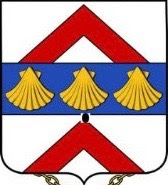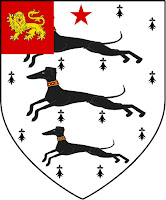 |
| Trevanion Coat of Arms [Argent, on a fess Azure, between two chevrons Gules, three escallops Or] |
Two years before her own re-marriage to Sir Robert Naunton, Penelope Lower arranged the marriage of her ten-year-old daughter Dorothy to Maurice Drummond. When Thomas Lower died unmarried and childless at age 45 in February 1661, his widowed sister Dame Dorothy Drummond succeeded to Trefenty House (the other major estate, St Winnow in Cornwall, passed to a distant male cousin). Dorothy still had her two youngest daughters, Penelope and Jane, unmarried. Five months later in July 1661, Penelope Drummond was married to Edmund Plowden, heir to the Shropshire estate Plowden Hall. And within five years, Jane Drummond’s marriage was arranged to Charles Trevanion of Caerhays Castle. Dame Dorothy Drummond held firm to the Catholic faith throughout her life, and saw to it that her three eldest daughters married into families of that faith.
 |
| Trefenty Old House, Carmarthenshire [Image by Dyfed Archaeological Trust] |
 |
| Drummond Coat of Arms |
JANE DRUMMOND, b. c.1640; d. by 4 July 1710 (when her will was proved), bur. St Clement Danes, London, yst dau. of Sir Maurice Drummond of Westminster (d. 1642) and Dorothy Lower (1607-1677, descended from Edward III - see Generation 13 below); m. by 1666, CHARLES TREVANION of Caerhays Castle, Cornwall, b. c.1631; d. 26 Nov. 1703, bur. St Michael Church, Caerhays, son of John Trevanion, Heir of Caerhays Castle (1613-1643, descended from Edward III) and Anne Arundell (c.1611-1701, descended from Edward III), and had issue, two sons and one daughter.
Issue of Charles and Jane (Drummond) Trevanion:
1) JOHN TREVANION of Caerhays Castle, b. 1667; d. 15 Aug. 1740 Caerhays Castle, bur. St Michael Church, Caerhays, M.P. Tregony 1705-08, Bodmin 1708-10, Cornwall 1710-22; m. 1st by 1699, ANNE BLAKE, b. c.1675; d.s.p. by 12 Nov. 1725 (when administration of estate was granted), dau. of Sir Francis Blake of Ford Castle, Northumberland (1638-1718, descended from Edward I) and Elizabeth Carr (1640-by 1713, descended from Edward III); m. 2nd 29 Mar. 1726, Hon. BARBARA BERKELEY, bap. 13 Nov. 1704 St Martin in the Fields, London; d. 16 Mar. 1772 Bath, Somersetshire, dau. of William, 4th Baron Berkeley of Stratton (c.1666-1741, descended from Edward I) and Frances Temple (d. 1707), and had issue, one son and two daughters.
Issue of John and Hon. Barbara (Berkeley) Trevanion:
1A) WILLIAM TREVANION of Caerhays Castle, b. 15 Mar. 1727; d.s.p. 24 Jan. 1767, bur. St Michael Church, Caerhays, M.P. Tregony 1747-1767; m. 19 May 1758 St George Hanover Square, London, as her 1st husband, ANNE BARLOW, bap. 7 Nov. 1737 St Mary Church, Haverfordwest, Pembrokeshire, d.s.p. by 1792, only dau. of George Barlow of Slebech Hall, Pembrokeshire, and Anne Blundell.
1B) FRANCES TREVANION, b. 1728; d. 25 Dec. 1762 The Hyde, East Hyde, Luton, Bedfordshire, bur. 1 Jan. 1763 St Mary Church, Luton; m. 25 Mar. 1753 St Mary Church, Reading, Berkshire, as his 1st wife, Dr. JOHN BETTESWORTH of East Hyde, bap. 30 Oct. 1720 St Margaret Church, Westminster; d. 22 Sept. 1779 The Hyde, bur. St Mary Church, Luton, son of Dr John Bettesworth of Northchurch, Hertfordshire, dean of the Arches (1677-1751) and Elizabeth Jones, and had issue, one son.
 |
| The Hyde, East Hyde, Luton, Bedfordshire, c.1967 [Image from 'Ames of Bristol', Landed Families of Britain and Ireland] |
2) CHARLES TREVANION aka DRUMMOND, Catholic priest, b. c.1669 Caerhays Castle, Cornwall; d. unm. 16 Mar. 1737 Richmond, Surrey.
3) MARY WINIFRED TREVANION, b. c.1670; d. unm. Jan. 1699 London, will dated 7 Jan. 1699, proved 26 Jan. 1699.
Ruvigny traces the descendants of Dorothy (née Devereux), countess of Northumberland (see Generation 12 below) in Table VI (p. 7) of the Isabel of Essex volume. He has her first husband Sir Thomas Perrot, but omits their daughter Penelope, and only gives Dorothy's issue from her second husband Henry, 9th Earl of Northumberland. So the following descent from Edward III to Lord Byron is an addition to Ruvigny.
Edward III had a second surviving son,
 |
| Isabel (née Plantagenet), Countess of Essex - see Generation 5 |
2) Lady Philippa Plantagenet of Clarence (1355-1377) m. Edmund Mortimer, 3rd Earl of March (1352-1381), and had
3) Roger Mortimer, 4th Earl of March (1374-1398) m. Lady Alianore Holland (1370-1405, descended from Edward I), and had
4) Lady Anne Mortimer (1388-1411) m. Richard of York, 3rd Earl of Cambridge (1385-1415, descended from Edward III), and had
5) Lady Isabel Plantagenet (1409-1484) m. 2) Henry Bourchier, 1st Earl of Essex (1404-1483, descended from Edward III), and had
6) William, Lord Bourchier (c.1428-1477) m. 2) Lady Anne Woodville (c.1448-1489), and had
7) Cecily Bourchier (c.1473-1493) m. John Devereux, 2nd Lord Ferrers of Chartley (1464-1501, descended from Edward I), and had
8) Walter Devereux, 1st Viscount Hereford (c.1491-1558) m. 1) Lady Mary Grey (c.1492-1538, descended from Edward III), and had
9) Sir Richard Devereux of Lamphey (by 1513-1547) m. Lady Dorothy Hastings (c.1520-1566, descended from Edward III), and had
10) Walter Devereux, 1st Earl of Essex (1539-1576) m. Lettice Knollys (1543-1634, descended from Edward III)[*1], and had
 |
| Dorothy (née Devereux), Countess of Northumberland - see Generation 11 |
12) PENELOPE PERROT, b. c.1590; d. by 23 Mar. 1655 (when administration of estate was granted); m. 1st (settlement 13 Aug.) 1605, Sir WILLIAM LOWER of St Winnow, Cornwall, M.P. Bodmin 1601, Lostwithiel 1604, b. c.1570; d. 12 Apr. 1615 Trefenty House, Carmarthenshire, Wales, est son of Thomas Lower of St Winnow (d. 1610) and Jane Reskymer (1552-1615, descended from Edward I), and had[*2]
13) DOROTHY LOWER, b. 1607; d. by 16 Dec. 1679 (when her will was proved), bur. St Clement Danes, London; married by 1617, Sir MAURICE DRUMMOND of Westminster, d. by 13 May 1642 (when his will was proved), son of David Drummond and Margaret Graham, and had[*3]
14) JANE DRUMMOND (c.1640-1710) m. Charles Trevanion of Caerhays Castle (c.1631-1703) - see details above, and had
15) JOHN TREVANION of Caerhays Castle (1667-1740) m. 2) Hon. Barbara Berkeley (1704-1772) - see details above, and had
16) SOPHIA TREVANION (1730-1790) m. Hon. John Byron of Plymouth (1723-1786) - see details above, and had
 |
| Lord (6th Baron) Byron - see Generation 18 |
18) GEORGE GORDON, 6th Baron Byron of Rochdale, famous poet 'Lord Byron', b. 22 Jan. 1788 Marylebone, London, bap. 1 Mar. 1788 St Marylebone Parish Church; d. 19 Apr. 1824 Missolonghi, Greece, bur. 16 July 1824 St Mary Magdalene Church, Hucknall Torkard.
[*1] Lettice Knollys was the daughter of Katherine (née Carey) Knollys, who was in turn the daughter of 'the Other Boleyn Girl' Mary Carey, sister of Queen Anne Boleyn. This makes Jane (née Drummond) Trevanion a mtDNA (unbroken female line) descendant of Lady Mary (née Boleyn) Carey. As Jane Trevanion's only daughter predeceased her, childless, Jane's mtDNA line from Mary Boleyn went extinct on her own death.
 |
| Sir Robert Naunton (1563-1635) |
[*2] Penelope (Perrot) Lower by her first husband, had an only surviving son, Thomas Lower of Trefenty House, M.P. East Looe 1640, b. 8 Dec. 1615; d. unm. 5 Feb. 1661, bur. 21 Mar. 1651 St Clement Danes, London. Penelope m. 2nd 1618, Sir Robert Naunton of Letheringham Hall (1563-1635), and had further issue, an only child, Penelope Naunton (1620-1647), who m. 1st Paul, 2nd Viscount Bayning, and m. 2nd, Philip Herbert, later 5th Earl of Pembroke & Montgomery, and had issue by both husbands.
[*3] The other three daughters of Dorothy (Lower) Drummond were: 1) Henrietta Maria Drummond, b. c.1630; bur. 14 Apr. 1694 St Giles in the Fields, London, m. 1st Robert Middlemore of Edgbaston Hall (c.1624-1652), and had issue, m. 2nd William Roper of Brentford (1623-1685, descended from Edward III) and had further issue; 2) Margaret Drummond, b. c.1635; d.s.p. 1656, m. (settlement 2 Sept.) 1652, as his 1st wife, John, 1st Baron Caryll of Durford (1626-1711, descended from Edward III); and 3) Penelope Drummond, b. c.1639; d. 28 Apr. 1699, bur. St Clement Danes, London, m. July 1661, Edmund Plowden of Plowden Hall (1640-1677, descended from Edward I), and had issue.
The next blogpost will explore Lord Byron's descents from James IV of Scotland, through his mother Catherine (Gordon) Byron.
Cheers, ------Brad
Cheers, ------Brad

































